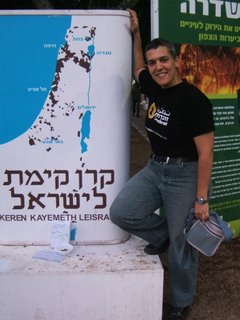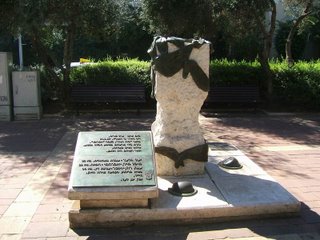The invitation said:
"Back to Bil'in - Mass Demo, Friday, October 27th"
"...It is already 20 months that the village Bil'in has been fighting for its life and future - a long, hard struggle, often frustrating. On
So... I went back to Bil'in.
After months of being away, speaking abroad about the demonstrations against the wall and their importance, showing pictures of the demonstrators' creativity and courage, the army's brutality, suddenly I did not really want to be there.
Maybe it was seeing Lymor in another demonstration the previous day (Lymor was shot in the head in Bil'in: http://mishtara.org/blog/?p=70), maybe it was the change of perspective - from afar, these demonstrations seem so much larger then life and less dusty... and maybe it was just what it felt it was - the dry mouth, the burn in the pit of my stomach, the smell of tear gas in the air, and all that just from reading the invitation.
After a sleepless night, I took a sweater and a water bottle (the things that make us feel safer...) and joined about 200 other Israelis on different routes to Bil'in. So many people! and so many dear friends... some chatty, some somber. Maybe it was just me, but on our complicated way to Bil'in, all seemed to be focused on the same things - the smell, the sound, the future pain of violence. What is it about violence that catches our attention so fully, that touches us so deeply, that makes it so... so serious? Am I serious? how serious am I? I didn't know I was that serious...
R, a good and wise friend, was my partner. Let's take it slowly, I asked, let's march in the back, maybe stay in the village... we stood while the men leaders of all Palestinian parties and Israeli groups marched by, followed by the organizers and the activists carrying ladders to be used to cross the wire fences, and the young men with flags and chants... I watched them in awe and admiration and envy and guilt, like a woman watching her champions going into battle, or a glorious anciet ceremony of sacrifice and victory.
We were climbing up the road towards the fence, in the tail of an impressive and colorful march, when we started hearing some blasts, coming from behind us. The soldiers. Behind us.
I stop. Suddenly I cannot breathe. I cannot go on, cannot go back. On both sides of the road there are ancient olive trees. I am amazed to see some women and children picking the olives. One woman, standing on a ladder over a tree near the road, is smiling at us, inviting us to join the children below, collecting the olives into bags. I take their picture. Feeling guilty again, for being a tourist, for stalling, for not helping at least with the picking.
The mass of the demonstration is before us, up on the hill just in front of a row of soldiers and a gate in the fence. To the side we can see a group of activists using the ladders to cross the barbed wire; they are being shot at, gassed, concussion grenades go off in blasts at their feet. The blasts make me very white and heavy. I tell R to go on. Leave me here, go on to the front. I do not want to shame her by my cowardice. You are missing the whole demonstration, I tell her, and she says, the demonstration is here too.
Finally she takes my hand and we go on. We go up the hill and join the rest of the demonstration. People are chatting and chanting and waving flags and interviewing and watching the soldiers and each other intently. The activists who crossed over the fence are being chased by the soldiers. I stand among friends on that hill, and they are all alert and alive and tense and now I can relax.
When the first round of tear gas reaches us, we are prepared for retreat. I keep calculating wind directions and shouting suggestions to whoever wants to hear them. But the wind keeps changing. The blasts get nearer. We go down the hill and down the road to the village. Slowly. And then faster, and finally, as usual, we run some. I am reminded of other demonstrations. Stumbling through stony fields, falling down, blinded by the gas, choking, being chased by guns and horses and batons and fear, running for my life. But not this time. This time, being more afraid then ever, I am not surprised by the attack, it is almost a relief to actually smell the foul thing. I am alive.
Some gas canisters shoot over our heads and explode on the road blocking our escape. We go into the olive grove to avoid them, and there they are, the olive picking family. The children have some cloth covering their mouths and noses from the gas. They are picking olives.
Later, when the rest of the demonstrators were chased off by more and more rounds of tear gas and concussion grenades and rubber-coated bullets, we could still hear the continuing blasts and shots aimed at some stone-throwing children. Some wounded, some arrested and I was shopping for really cheap Labane and Yogurt to take home for the weekend.
Only much much later, on the bus home, I realized that in all this time I used my camera only once, and that the only picture I took was of the woman picking olives.
Other reports about this demonstration: by Yonathan Pollak, by Bill Dienst and the ISM Report.
More about the village and its struggle here.
























